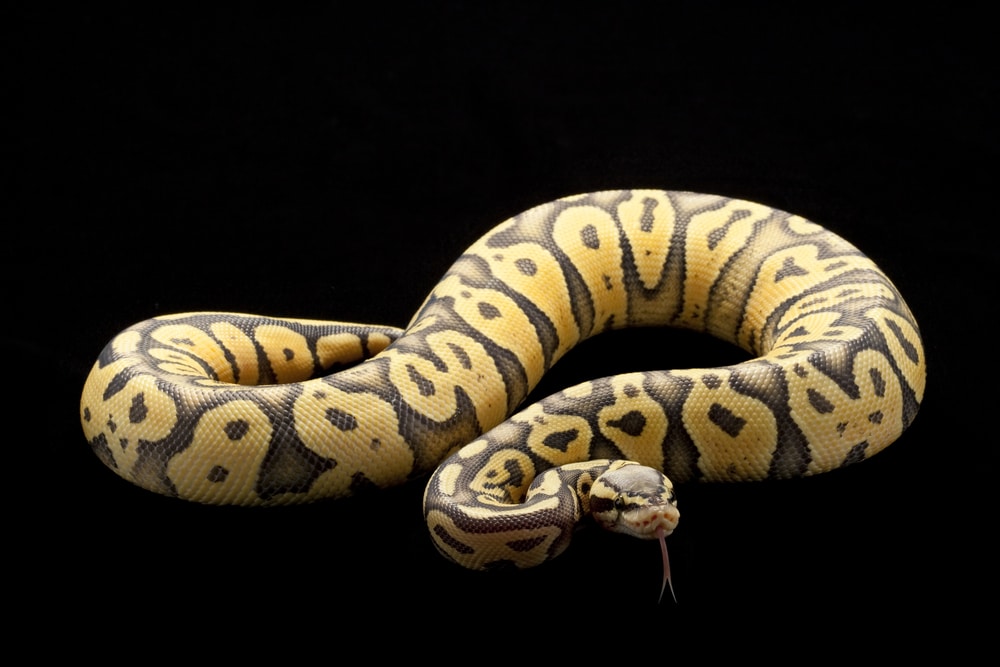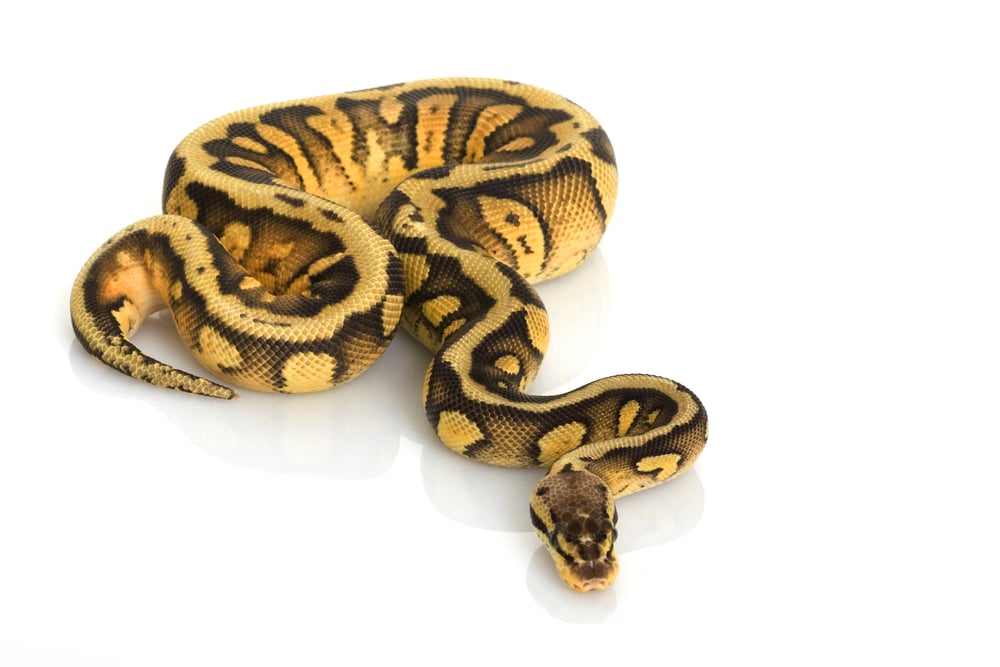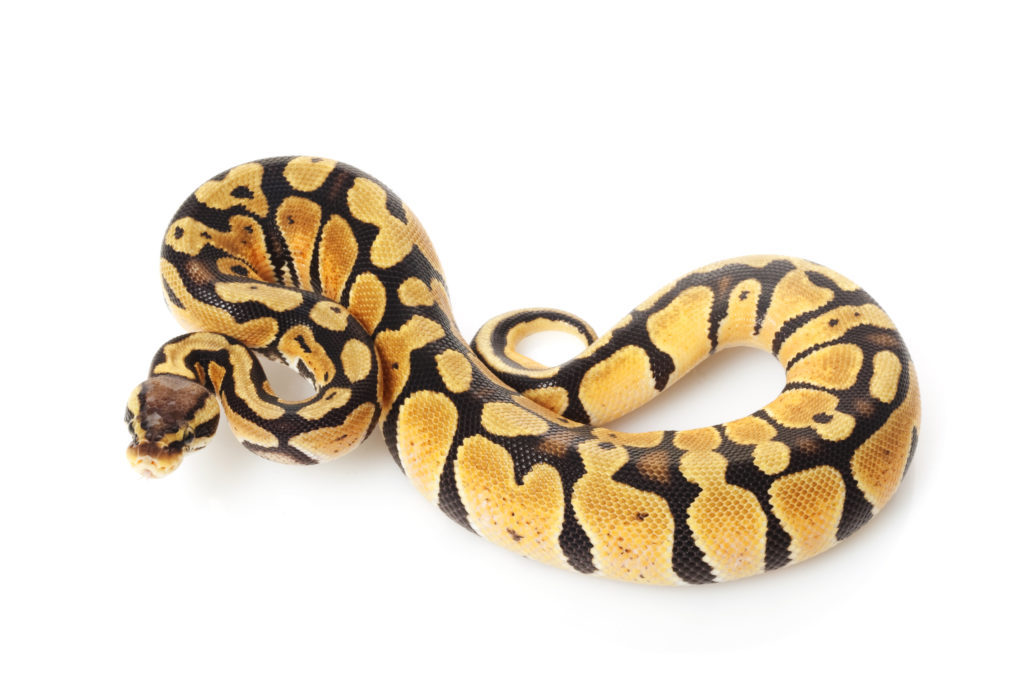In May 1994 Greg Graziani acquired a very brightly colored male ball python from a Miami reptile importer. The next year, at the National Reptile Breeders Expo, Graziani discovered that Kevin McCurley from New England Reptile Distributors (NERD) had a female which looked just like his.
Both Graziani and McCurley were certain their snakes’ coloration was a genetic mutation. Neither wanted to sell their unusual ball python, and so in 1997 Graziani bred his “Type 2 Jungle” to a normal female.

When the normal female laid eggs, Graziani expected a clutch of normal-looking ball pythons which were (or might be) heterozygous for the male’s color. But on July 22, 1997, when the babies hatched, he discovered that all seven of his baby balls looked like their father!
Later Graziani discovered NERD had bred their female. While only one of the three eggs hatched, it looked identical to his babies. McCurley was calling his animals “Pastel Jungles.” Since that was catchier than “Type 2,” Graziani changed the name of his animals. Today we still call this morph Pastel Ball Pythons.
Graziani sold his first Pastels for $2,500 each. Today you can get a Pastel ball python for $100 or less. Pastels are widely found throughout the ball python trade. They even come in several different flavors you can mix and match to produce spectacular dual Pastels.
This article will introduce you the Pastel ball python morph, so you can decide for yourself if Banana balls are right for you.
Quick Navigation
Pastel Ball Python Morph Appearance
The Pastel ball pythons introduced by Graziani and NERD are lighter than normal ball pythons, with much of their brown pigment replaced by shades of dark yellow to burnt orange. Their dark pattern is sharply defined, but has faded lighter patches in the center called “blushes.” They have beautiful light-colored eyes which come in shades of gold or green.
Soon after the introduction of the Jungle Pastel, several other variants of the Pastel morph arrived on the market.
- Black Pastel: First produced in 2002 by Gulf Coast Reptiles, Black Pastels have high-contrast patterns with dark gold or rust colored backgrounds.
- Cinnamon Pastel: Often just called “Cinnamons,” the Cinnamon Pastel looks like a lighter Black Pastel with a dark cinnamon background. Proven by Greg Graziani in 2002.
- Lemon Pastel: Lemon Pastels, produced by NERD in 2002, are lighter than the Jungle Pastel and keep their baby yellow coloring into adulthood.
There is considerable variation between individual Pastel balls of any type. Some are darker or lighter; some have more or less blushing; some have higher or lower contrast in their patterns. Many Pastels also have reduced patterns and thinner saddles. (Black Pastels frequently flaunt oval-shaped “keyholes” and “alien heads” along their sides).
There can be some issues with the Super forms of the Black Pastel and Cinnamon morphs. But for the most part, Pastels are as healthy as any normal ball python and just as easy to keep.

Genetics and Pattern of Inheritance
When Greg Graziani bred his first Pastel, he expected to wait several years before finding out whether or not the mutation was heritable. At the time all known ball morphs were recessive. A Piebald or Albino ball requires two pairs of the gene which transmits the trait. If one parent lacks that gene the offspring will be “hets” who look normal but who carry a copy of the gene.
The Pastel morphs are co-dominant. One copy of the gene will produce the visible mutation. When a Pastel ball mates with a non-Pastel, half the offspring will be Pastels. The other will be normal appearing balls who do not carry any copies of the Pastel gene.
When a Pastel is mated with another Pastel, one-quarter of the offspring will inherit the normal gene from both parents. Half will be Pastels. And one-quarter will be Super Pastels.
A Super Pastel is more brightly yellow than a Pastel, with high blushing and high contrast in its patterns. Breed a Super Pastel to another ball and 100% of the offspring will be Pastels.
Super Pastels are highly prized by breeders. A Super Pastel bred to a Clown will produce a clutch of Pastels het Clown. Breed those hets to Clowns and 25% of the offspring will be Pastel Clowns.
The Cinnamon, Black and jungle/Lemon lines appear to operate on different parts of the gene.
- Breeding a Pastel x Black Pastel produces a silvery Black Pewter.
- A Cinnamon x Black Pastel pairing will produce a clutch of 25% normals, 25% Cinnamons, 25% Black Pastels and 25% Cinnamon Black Pastels, a dark snake called an 8-Ball.
- Pastel x Cinnamon Pastel produces 25% normals, 25% Black Pastels, 25% Pastels, and 25% coppery-gray Pastel Black Pastel Pewters.
The different Pastel lines are all beautiful alone or in combination with other morphs. But when breeding Black or Cinnamon Pastels together, you may run into unexpected complications.
Potential Problems: Duck Bills, Bug Eyes and Kinks in Supers
The Super Black Pastel and Super Cinnamon (offspring of a Black/Cinnamon x Black/Cinnamon pairing) are both dark-colored snakes. The Super Black Pastel tends more toward black, while the Super Cinnamon is dark rust that fades to white near the belly.
These Supers are impressive snakes. Breeding them to any morph will produce a clutch of 100% Black or Cinnamon Pastels. But they can sometimes show skeletal malformations called “duckbills,” excessively large “bug eyes,” and spinal kinks.
These problems do not show up in Super Pastels of the Lemon/Jungle line with greater than normal frequency. Fluctuations in incubator temperatures can cause kinking and duckbill, and occasionally normal ball pythons are born with overly large, overly small or even missing eyes.
But these defects are rare in balls which are properly incubated and whose parents do not show these defects. Among Super Black Pastels or Super Cinnamons, they appear far more often. But there are ways of limiting the risk of deformed snakes in your clutches.
When breeding for Super Blacks or Cinnamons, you should start with unrelated snakes. Breeders often “line breed” by breeding the offspring back to the parent or mating offspring with each other. (This is most often done to prove new morphs).
Line breeding can prove a morph, but it also increases the chances of harmful mutations. Breed your Blacks or Cinnamons with other balls. The more outbreeding you do, the less chance you have of producing snakes with unsightly mutations.
The genetic issues which arise in Super Blacks and Cinnamons found with less frequency in the Black Pastel Cinnamon “8-Ball” combination. Neither do they appear among Black Pastels and Cinnamons carrying only one copy of the co-dominant allele.
If one of your snakes is born with serious kinks that impair movement, you may want to euthanize it. But though duckbills, bug eyes and mild kinks may be unsightly, they are not necessarily crippling. Most of these snakes can live long and comfortable lives in captivity.
That being said, you should never breed a snake with these issues. They have a much higher chance of passing these deformities down to their offspring.

Popular Pastel Ball Python Combinations
The co-dominant Pastel morphs allow breeders to quickly create new combinations. As a result, there are many Pastel, Black Pastel and Cinnamon designer morphs. Some of these combinations include:
Pastel x Axanthic: Axanthic Pastels replace the Pastel yellow with a pale gray. If you breed two Axanthic Pastels together, 25% of the clutch will be even lighter Axanthic Super Pastels.
Black Pastel x Axanthic: The Axanthic’s gray color goes nicely with the alien head pattern common to Black Pastels. And if you mate a Black Pastel Axanthic to another Axanthic, half the clutch will be Black Pastel Axanthics.
Pastel x Banana: Banana Pastels are more brightly yellow than regular Bananas. A Cinnamon Pastel Banana will have brighter oranges, while a Black Pastel Banana will have darker purples.
Pastel x Clown: The Clown Pastel is one of the most impressive Pastel combinations, with brighter tans and paler patterns than a normal Clown. Breed two Pastel Clowns together and 25% of your clutch will be spectacular Super Pastel Clowns.
Pastel x Piebald: The Pastel morph lighten the Piebald’s saddles and heighten the color. If you breed two Pastel Piebalds together, 25% of the clutch will be spectacular Super Pastel Piebalds.
Black Pastel x Piebald: A Black Pastel piebald has dark saddles which beautifully offset the piebald patches. If you breed two Black Pastel Pieds, 25% of the clutch will be Super Black Pastels or “Panda Pieds.” Panda Pieds have near-black saddles which give them their name.
Pastel x Spider: Pastel Spiders are called “Bumblebees” for their brilliant yellow background and high-contrast lined patterns. A Super Pastel Bumblebee is known as a “Killer Bee.” But both Bumblebees and Killer Bees can be prone to the notorious “Spider Wobble.”
Not to be outdone, many designer Pastel balls have three or even more morphs. Some of the more impressive triple and quadruple Pastel combinations include:
- Banana Black Pastel Cinnamon
- Black Pastel Clown Ghost
- Black Pastel Fire Pastel Phantom
- Markus Jayne Axanthic Pastel Piebald
- Mojave Cinnamon Cream (Mojave Cinnamon Fire Vanilla)
- Pastel Dreamsicle (Pastel Lavender Albino Piebald)
- Pastel 8-Ball (Pastel Cinnamon Black Pastel)

Caring For A Pastel Ball Python
Your Pastel ball needs what every ball python needs. Give them adequate space. An adult Pastel should have a 4’ x 2’ cage: a juvenile ball will be happy in a 30-40 gallon aquarium. Give your Pastel a temperature gradient between 75° and 95° and a comfortable hiding space. Provide fresh water and keep their home clean.
Pastels, like other ball pythons, are generally docile. When frightened they are more likely to curl up in a ball (hence their name) than to bite. You can take them out to show your friends, but make sure everybody handles your snake gently!
Ball pythons have a reputation for being picky eaters. If your Pastel ball is refusing its prey, try feeding it smaller food items. You can also try scenting your frozen-thawed mice and rats with chicken broth.
Unless all else fails you probably should avoid live prey. If you must feed live rats or mice, stun or kill the animal before offering it to your ball. A cornered rodent can injure or even kill a snake.
If your Pastel still won’t eat, don’t worry. Unless your snake becomes alarmingly thin or their spine is showing, they will be fine. Ball pythons regularly go months without food in the wild.
Conclusion
Pastel balls are not a big investment. Even designer Pastel morphs can be had at reasonable prices, though some still sell for thousands of dollars. But don’t be afraid to spend a little more money if it means getting a healthy snake from a reputable breeder.
Do your research before buying. Online markets like Kingsnake Classifieds and Morph Market offer a variety of ball pythons and other snakes in every price range. Forums like Kingsnake Ball Python Forum, BP Forums and Fauna Classifieds Ball Pythons Forum will put you in touch with breeders and experienced owners who will be happy to offer advice.
Do you have a Pastel ball python? What advice would you give somebody thinking about adding a Pastel to their collection? Do you have any pointers or stories you would like to share? Let us know your thoughts in the comments below. And if you want to show off your Pastel, please feel free to share photos!